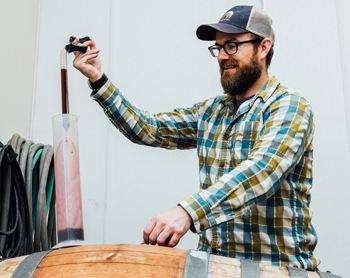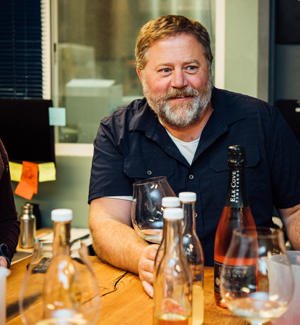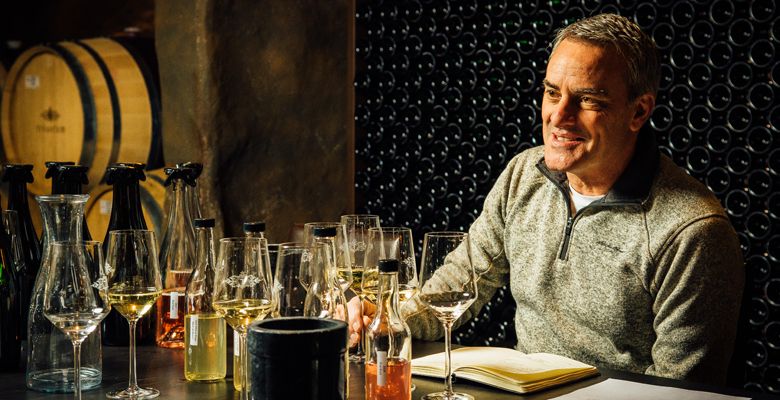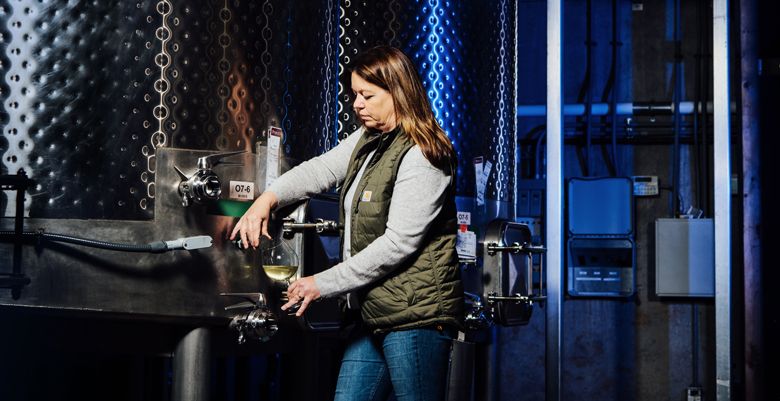Base Instincts
Story by L.M. Archer • Photography by Kathryn Elsesser

Ever wonder how bubbles get into that bottle of bubbly? Some say it starts with the base wines, or vins clairs, as they are referred to in Champagne. Like the canvas on which an artist paints, these base wines provide the starting point for the creation of sparkling wine.
“Tasting the vins clairs,” says Luisa Ponzi of Ponzi Vineyards, who made her first sparkling in 1996, but did not initiate her current program in earnest until 2013, “are evaluations, really, making sure the wines are where we want them now and imagining how they will evolve and develop over time.”

Fruit First
Yet base wines are only as good as their fruit. While production methods and styles may vary, Oregon sparkling winemakers all share a common belief: Great bubbles start in the vineyard. “When you look at all of the places to grow grapes in the United States,” says Adam Campbell of Elk Cove Vineyards, a pioneering family estate planted in the ’70s near Gaston, “Oregon should be top of the list for the right climate for doing this kind of work.”
Considered a cool-climate wine region, Oregon boasts a plethora of high-elevation microclimates suited to yielding grapes with high acid, low sugar and low phenolics necessary for crafting sparkling wine. “Site is particularly important for our program in building a single-vineyard base wine,” says Chris Williams of Brooks Wines, recognized for its Biodynamic Riesling program in the Eola-Amity Hills. ”We’re looking for vines that ripen fruit with low pH and high acidity, while still showcasing lots of varietal and site character. For us, this has meant working with an old-vine site planted in volcanic soils that benefits both from elevation and wind impact.”
Clones also matter. In addition to traditional selections such as Pommard and Dijon, many in the Willamette Valley now seek out delicate, floral Chardonnay clones like 352, cold-loving Pinot Noir clones like Mariafeld and fruit-forward Pinot Meunier. “Clones have also been important for us to consider,” adds winemaker Claire Jarreau of Brooks Winery. “Some Riesling clones offer higher concentrations of specific terpenes that we’ve found lovely in our still wine programs but not best suited to sparkling.”
Predicting Perfection
Much like a supermodel sans makeup, base wines must show lean and mean on the palate; it’s up to the winemaker to discern their potential perfection. “It’s not really about what these wines look like now,” says Andrew Davis of Radiant Sparkling Wine Company, who spearheads the Lytle-Barnett prestige sparkling project, a partnership between former Jackson Family Wine exec Andy Lytle and Anthony Beck of South Africa. “No one’s going to be drinking these,” says Davis. “These are all about what these wines are going to look like when he releases the 2018 in 2022.”

Predicting how a base wine will develop is an acquired skill. For beginning winemakers in the Chemeketa Community College Wine Studies program in Salem, Program Chair Scott Dwyer assigns students specific trials to oversee, from start to finish. “The Wine Studies program is largely based on still wines,” says Dwyer, “But we have integrated sparkling production into the program, both in the classroom and winery.”
Sparkling trials introduce Chardonnay, Pinot Noir and Pinot Blanc to a battery of different yeast strains, fermentations, stirring and aging vessels. “We try to address different styles and production methods,” Dwyer explains, “With the idea that if you understand why various wines are made differently, then you functionally understand how to make wine, rather than just how wine is made.”
For seasoned winemaker Robin Hawley, who has led Sokol Blosser’s sparkling program for five years at the winery’s Dayton facility, confidence to predict outcomes derives from practice. “To be honest,” she admits, “It’s intimidating. Because you’re putting this into a bottle, and you have to wait several years and hope it’s going to go where you want it to be.”

Pressing Makes Perfect
Another essential component to ensuring vibrant vins clairs revolves around proper picking and pressing protocols. Harvest typically occurs earlier than that for still wines, usually late August or early September. “Of course, the high acidity and low pH need to be there,” says winemaker Rob Stuart of R. Stuart & Co. in McMinnville. “What I am NOT looking for are green flavors. And they aren’t if the picking is done at the correct time and from the right vineyards. For the current vintage of vin clair, I want perky, bright, almost blazing, diamond-like laser flavors that are perfectly ripe.”
Unlike still wine, sparkling requires gentle pressing to minimize skin contact, which can result in harsh phenolics imparting unpleasant aromas and bitter flavors. James Frey of Trisaetum near Newberg utilizes a traditional three-part Champagne-method pressing cycle to achieve the delicate juice essential in crafting sparkling wine. “The reality is,” says Frey, who is also a professional abstract artist, “with sparkling, if you grow the fruit well, and you’re really particular about your press, by the time your press is done, you can only mess it up at that point. All the good stuff is done at that point.”
Frey picks and presses his estate fruit in 2.5-ton increments, matching the capacity of his press. After chilling the fruit overnight in his cold room, he separates the first pressing (‘tête’ or ‘head’), then the core (‘coeur’ or ’heart’), then the final pressing (‘taille’ or ‘cut,’ here referred to as the ‘tail’), slowly building pressure with each cycle. In total, Frey employs three turns of the press. “We’re pretty particular, and we calculate it all out,” he says, “So we know exactly how many gallons the head needs to be, what the heart’s going to be, and then the tail. But by chilling, and not over-rotating, I think we’re able to keep the phenolic character down, and I like that.”

Science of Bubbles
Once pressed, chemistry looms large every step of the way, from initial fermentation and blending (assemblage) of the base wines, to subsequent tirage (adding yeast and sugar to initiate secondary fermentation in bottle), aging, disgorgement, dosage, sealing, cellaring and selling the finished product. “You almost have to approach winemaking a little bit differently,” says Hawley, “Less artistically, and more thinking about the science of it.”
Sparkling wines require low pH (~3), high acids (~7-9), and low sugars (<19-20 brix) to elicit their trademark crispness. Beyond the science, stylistic adjustments abound. A few, such as Frey, put his base wines through secondary fermentation to transform bright, green apple-tasting malic acid produced during the initial fermentation into round, creamy lactic acid. But most winemakers prefer to retain freshness and vitality by eschewing malolactic fermentation, and/or aging in stainless steel or neutral vessels. “The use of oak opens up the palate, makes it broader, you see a lot of the white flower components, you see some of the yeast coming up,” says Davis,” And with the stainless steel, the difference is that it’s a lot more closed-in and focused, and plays more on ripe, lemony notes … it’s just amazing what that shift in vessel will do.”
Another way to add complexity to sparkling wine involves judicious additions of vins clairs during assemblage or dosage. A handful of winemakers — Rob Stuart and Luisa Ponzi among them — are holding back a portion of their production each year for this purpose. Stuart deliberately blends current vintage vin clair with aged vin clair into his Rosé d’Or sparkling wine. “The trick for me,” says Stuart, “is to blend the older wine with the bright, young wine to give me that balance of complexity and yet not go over the ‘tips of my skis.’”

Oregon Style
Unlike the strict rigors required to produce classic Champagne, the Oregon sparkling wine industry pulses with a jazz-like joie de vivre. “What I find so fun about sparkling is, unlike still wine, to a certain extent you’re free from constraints,” says Ponzi. “The wine is bottled and then there is the opportunity to look at it again. It is still so bizarre to me, that you can come back five years later, and say, ‘Ah, I want to add a little aged Chardonnay to this.’ Or, ‘It needs a little sweetness to balance that acidity.’ That ability to perfect and tweak a wine in bottle is really compelling and so fun.”
Campbell concurs, “It fits with what we do for still wine, which is small, high quality. A lot of family-owned businesses — not the big Champagne houses — they have their own thing, but it’s more about glitz. We think of it more like a grower Champagne model here, which is exciting, I think.”
Davis also notices a trend in Oregon sparkling toward reserve tier Pinot pricing, about the same cost as grower Champagne. “Even though the styles are diverse, I think we’re seeing an Oregon sparkling style already come out, and it pairs quite closely with the Oregon still wines,” he concludes. “It’s a little bit more fruit-forward, but it has plenty of acidity, and it’s very highly well made. If it is going to be priced on par with grower Champagne, it better damn well be as good as grower Champagne.”













